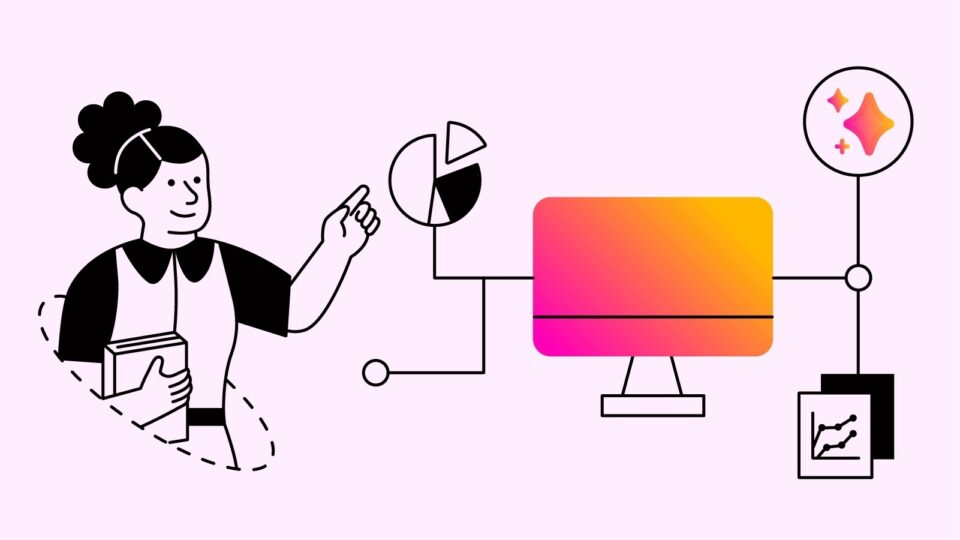
Current trends in educational technology point to (you guessed it!) AI. According to HMH’s annual survey of educators, the use of AI in the classroom has increased sixfold since 2023. Sixty-eight percent of educators say it saves them up to five hours each week. That extra time can make all the difference.
“When educators have more time to connect with students, teaching and learning thrive,” says Francie Alexander, SVP of efficacy research at HMH.
Top K–12 edtech trends fueled by AI
Here are four AI-driven trends in edtech that are changing the way teachers teach and students learn.
1. Self-directed learning
More schools are using AI-driven programs to help students take charge of their own learning. These programs can keep students engaged by providing instant feedback, breaking down difficult concepts, or assigning practice tasks that adapt to each learner. Whether students need to catch up on a concept or move on to new challenges, learning can continue uninterrupted. HMH offers AI-supported adaptive math or ELA practice with Waggle, oral fluency practice from Amira, and writing practice and feedback in Writable.
2. Automating teacher tasks
Teachers are leaning on AI tools to automate tasks like lesson planning, quiz creation, and even grading. With AI working for them, teachers say they have more time to focus on differentiating instruction and building relationships with students. The tools also hold the potential to improve efficiency and reduce teacher burnout.
Give HMH AI Tools a test run. Create an account if you don’t already use the HMH Ed platform. In addition to help with tasks like writing lesson plans and quizzes, you can:
- Get translations: Translate any text or resource into other languages.
- Explain math and science: Get simple explanations and sample problems for teachers and caregivers.
- Create report card comments: Get comments that recognize progress and guide growth.
- Write an email: Craft professional emails to caregivers or colleagues, in any language.
3. Building AI literacy
We’re seeing a push nationwide for teachers and students to develop AI literacy, an understanding of how AI works and how to use it ethically. There’s even a National AI Literacy Day in March that brings together students and teachers to learn about the benefits and drawbacks of this technology. Here are free teaching resources for schools:
- Interactive activities and tutorials from the Hour of AI initiative
- PD for teachers and instructional resources on the AI Literacy Day web page
- Lessons and hands-on projects from ISTE
4. Creating guidance for AI use
As schools across the country adopt AI tools, many states have issued guidance on how to use these tools in classrooms. So far, around 28 states have published AI guidance for K–12 schools, and more states are working on them, according to the Education Commission of the States. Among the policy aims: protect student data, encourage student and teacher literacy, and ensure the ethical use of AI.
The opportunity to support teachers is off the charts right now. It’s an exciting time in teaching and edtech.
Executive Vice President of HMH Labs
The case for professional development in AI
It’s no wonder that technology trends in education are largely AI-driven. Teachers want time back and AI delivers. With shorter to-do lists, teachers can focus on leading lively whole-class discussions, guiding small-group projects, and giving one-on-one time to the students who need it.
But many teachers don’t get the professional development they need to make the most of AI. In our recent report on the teaching profession, 36% of educators said they’ve received no training in AI, and 54% said they’ve received “some.”
“As AI tools become more embedded in daily practice, educators are looking for meaningful support—training, guidance, and clear expectations—to ensure AI strengthens, not replaces, the human work at the center of teaching,” says Jack Lynch, HMH CEO.
What’s next for technology trends in education
There’ll be no shortage of edtech innovations in the future. A conversation with an Elizabeth Cady Stanton chatbot, anyone? How about learning to weld using VR or playing a video game that takes you on a hyper-personalized learning journey based on behavior patterns and real-time data? These immersive experiences are still being perfected and are emerging trends to watch.
“For years we’ve been making promises of what edtech could do for teachers, but now it’s happening,” says Andrew Goldman, EVP of HMH Labs, an incubation team focused on edtech development. “The opportunity to support teachers is off the charts right now. It’s an exciting time in teaching and edtech.”
Give us your take on edtech trends
Which educational technology trends do you see making their mark in your school or district? Which are worth keeping? Which won’t last? Share your thoughts with us on Facebook, Instagram, or via email at shaped@hmhco.com.
***
Get monthly education news updates and thought leader insights delivered straight to your inbox. Sign up for our Shaped newsletter.
HMH AI Tools are designed to teach with you, not for you.














